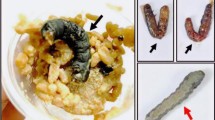Abstract
The larva ofPseudaletia unipuncta (Haworth) is susceptible to 2 nuclear polyhedrosis viruses (NPV), the typical (TNPV) and the hypertrophy (HNPV) strains. The interference between the 2 viruses was studied primarily in the tracheal and fat tissues. When both viruses were microfed simultaneously, no larva had mixed virus infections and most were infected with TNPV. In order to obtain 50% infection by each virus the inoculum of HNPV had to be increased by 1000 polyhedra/ml at the LD50 value of TNPV. Mixed infection resulted when TNPV was inoculated 1 and especially 2 days after HNPV inoculation. In mixed infection, each virus attacked certain areas of the tracheae instead of random cells. These results indicated an interference or antagonism between the 2 viruses. The possible cause for the interference is discussed.
Résumé
La larve dePseudaletia unipuncta (Haworth) est sensible à 2 virus à polyèdres nucléaires (NPV), la souche typique (TNPV) et la souche causant une hypertrophie (HNPV). L'interférence entre ces 2 virus a été étudiée essentiellement dans les trachées et le corps adipeux. Si les deux virus sont inoculés simultanément par micro ingestion aucune larve ne présente d'infection mixte et la plupart d'entre elles est infectée par le TNPV. Pour obtenir 50% d'infection par chacun des virus, l'inoculum de HNPV doit être accru de 1000 polyèdres par ml par rapport à l'inoculum provoquant la DL 50 du TNPV. Une infection mixte est enregistrée quand le TNPV est inoculé 1 jour et de préférence 2 jours après l'introduction du HNPV. Dans ce cas d'infection mixte chaque virus attaque certaines régions des trachées et non pas des cellules réparties au hasard. Ces résultats prouvent une interférence ou un antagonisme entre les 2 virus, dont la cause est discutée.
Similar content being viewed by others
References
Aruga, H., Hukuhara, T., Yoshitake, N. &Israngkul Na Ayudhya A. — 1961. Interference and latent infection in the cytoplasmic polyhedrosis of the silkworm,Bombyx mori (Linnaeus). —J. Insect Pathol., 3, 81–92.
Bird, F. T. — 1959. Polyhedrosis and granulosis viruses causing single and double infections in the spruce budworm,Choristoneura fumiferana Clemens. —J. Insect Pathol., 1, 406–430.
Bliss, C. I. — 1935. The calculation of the dosage-mortality curve. —Ann. Appl. Biol., 22, 134–167.
Gershenson, S. — 1959. Mutation of the polyhedral viruses. —Dokl. Akad. Nauk. SSSR., 128, 622–625.
Kaya, H. K. — 1970. Toxic factor produced in virus-infected armyworm larva: effect on the parasitoid,Apanteles militaris (Walsh) [Hymenoptera: Braconidae]. —Ph. D. Diss. Univ. California, Berkeley, 193 pp.
Kaya, H. K. &Tanada, Y. — 1973. Hemolymph factor in armyworm larvae infected with a nuclear-polyhedrosis virus toxic toApanteles militaris. —J. Invertebr. Pathol., 21, 211–214.
Lowe, R. E. &Paschke, J. D. — 1968 a. Simultaneous infection with the nucleopolyhedrosis and granulosis viruses ofTrichoplusia ni. —J. Invertebr. Pathol., 12, 86–92.
— — 1968 b. Pathology of a double viral infection ofTrichoplusia ni. —J. Invertebr. Pathol., 12, 438–443.
Tanada, Y. — 1967. Microbial pesticides. In: Pest Control Biological, Physical, and Selected Chemical Methods (W. W. Kilgore &R. H. Doutt eds). —Academic Press, New York, 31–88.
Tanada, Y. — 1971. Interactions of insect viruses, with special emphasis on interference. In: The Cytoplasmic-Polyhedrosis Virus of the Silkworm (H. Aruga & Y. Tanada eds). —Univ. Tokyo, 185–200.
— — 1976. Ecology of insect viruses. In: Perspectives in Forest Entomology (J. F. Anderson &H. K. Kaya eds). —Academic Press, New York, 265–285.
Tanada, Y., Hess, R. T. &Omi, E. M. — 1975. Invasion of a nuclear polyhedrosis virus in midgut of the armyworm,Pseudaletia unipuncta, and the enhancement of a synergistic enzyme. —J. Invertebr. Pathol., 26, 99–104.
Tanada, Y. &Hukuhara, T. — 1971. Enhanced infection of a nuclear-polyhedrosis virus in larvae of the armyworm,Pseudaletia unipuncta, by a factor in the capsule of a granulosis virus. —J. Invertebr. Pathol., 17, 116–126.
Tanada, Y., Hukuhara, T. &Chang, G. Y. — 1969. A strain of nuclear-polyhedrosis virus causing extensive cellular hypertrophy. —J. Invertebr. Pathol., 13, 394–409.
Tanada, Y. &Watanabe, H. — 1971. Disc electrophoretic patterns of hemolymph proteins of larvae of the armyworm,Pseudaletia unipuncta, infected with a nuclear-polyhedrosis and a granulosis virus. —J. Invertebr. Pathol., 17, 127–129.
Tanaka, S. &Aruga, H. — 1967. Interference between the midgut nuclear-polyhedrosis virus and the cytoplasmic-polyhedrosis virus in the silkworm,Bombyx mori L. —J. Sericult. Sci. Japan, 36, 169–176.
Tarasevich, L. M., Kozhukharova, M. I. &Obhodova, T. A. — 1977. On the influence of alien virus on specific viral infections of insect-host. —Izvest. Akad. Nauk SSSR, Biol. No. 1 Jan.–Feb., pp. 125–131.
Vago, C. — 1963. Predispositions and interrelations in insect diseases. In: Insect Pathology, An Advanced Treatise (E. A. Steinhaus ed.). —Academic Press, New York, vol. 1, 339–379.
Watanabe, H. &Kobayashi, M. — 1970. Histopathology of a granulosis in the larva of the fall webworm,Hyphantria cunea. —J. Invertebr. Pathol., 16, 71–79.
Watanabe, H. &Tanada, Y. — 1972. Comparative histopathology in larvae of armyworm,Pseudaletia unipuncta Haworth (Lepidoptera: Noctuidae), infected with two strains of a nuclear-polyhedrosis virus. —Appl. Entomol. Zool., 7, 9–16.
Whitlock, V. H. — 1977. Simultaneous treatments ofHeliothis armigera with a nuclear polyhedrosis and a granulosis virus. —J. Invertebr. Pathol., 29, 297–303.
Author information
Authors and Affiliations
Additional information
Portion of a dissertation submitted by the senior author for the degree of doctor of philosophy from the University of California, Berkeley. Part of the study was supported by a NSF grant provided to the junior author.
Rights and permissions
About this article
Cite this article
Ritter, K.S., Tanada, Y. Interference between two nuclear polyhedrosis viruses of the armyworm,Pseudaletia unipuncta [Lep.: Noctuidae] . Entomophaga 23, 349–359 (1978). https://doi.org/10.1007/BF02373052
Published:
Issue Date:
DOI: https://doi.org/10.1007/BF02373052




